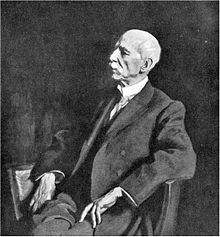- Manuel García (baritone)
-
 Garcia, aged 100 by John Singer Sargent
Garcia, aged 100 by John Singer Sargent
Manuel Patricio Rodríguez García (17 March 1805 – 1 July 1906), was a Spanish singer, music educator, and vocal pedagogue.
Contents
Biography
García was born on 17 March 1805 in the town of Zafra in Badajoz Province, Spain. His father was singer and teacher Manuel del Pópulo Vicente Rodriguez García (Manuel García I, 1775–1832). His sisters were María Felicia García Sitches (1808–1836) and Michelle Ferdinande Pauline García (1821–1910). After abandoning his onstage career as a baritone, García began to teach at the Paris Conservatory (1830–48) and the Royal Academy of Music, London (1848–95). Jessie Bond, Camille Everardi, Erminia Frezzolini, Jenny Lind, Mathilde Marchesi, Christina Nilsson, Julius Stockhausen, Marie Tempest, and Henry Wood were among his pupils. He invented a laryngoscope in 1854 and the next year published observations of his own larynx and vocal cords made with a small dental mirror introduced into the throat and using sunlight reflected by another mirror.[1][2] García was interested in movements connected with the production of the singing voice and did not anticipate the importance of laryngoscopy for medicine. Still, the University of Königsberg conferred upon him the honorary degree of M.D. He died in London in 1906 at the age of 101 years and was buried in the churchyard of St. Edward's Catholic church in Sutton Green, Surrey. His grave gives details of his many famous pupils and accomplishments.
On 22 November 1832 in Paris García married the operatic soprano Cécile Eugénie Mayer (Paris, 8 April 1814 – Paris, 12 August 1880). They had two sons and two daughters.[3] Their son Gustave Garcia (1837–1925) was a singer, actor, and author of three books on vocal and stage techniques. Gustave's son, Alberto García (1875–1946), studied voice with his great aunt (Pauline Viardot), became a respected baritone, and produced an edition of his grandfather's treatise on singing (1924).[4]
Works
- Mémoire sur la voix humaine présenté à l'Académie des Sciences en 1840. Paris: Duverger, 1847.
- Ecole de García: traité complet de l'art du chant par Manuel García fils. Mayence, Paris: Schott 1840 (Teil 1), 1847 (Teil 2).
- Garcías Schule oder Die Kunst des Gesanges in allen ihren Theilen vollst. abgehandelt von Manuel García. Deutscher Text von C. Wirth. Mainz: Schott, 1841; auch in zwei Teilen in der Zeitschrift Caecilia; Erster Theil, in Band 22 (1843), Heft 85; Zweiter Theil in Band 26 (1847), Heft 104 (Digitalisat)
- Ecole de García: traité complet de l'art du chant. (Band 1 und 2 zusammen). Mayence, Paris: Schott 1856.
- A complete treatise on the art of singing, part two by M. García II. Second part, complete and unabridged, the editions of 1847 and 1872 collated, ed. and transl. by Donald V. Paschke. Reprint of the 1872 edition. New York: Da Capo Press, 1975. ISBN 0-306-76212-9. ISBN 0-306-70660-1. (Note: Includes bibliographies).
References
- ^ Manuel García (1855). "Observations on the Human Voice". Proceedings of the Royal Society of London 7: 399–410. doi:10.1098/rspl.1854.0094. http://books.google.com/books?id=o6PYNM7RNwkC&pg=PA399&lpg=PA399&dq=%22Observations+on+the+Human+Voice%22+%22Proceedings+of+the+Royal+Society%22#v=onepage&q&f=false. Retrieved 28 August 2010.
- ^ American Otological Society (1905). The Laryngoscope. Volume 15, pp. 402-403
- ^ Sidney Lee (1912). Dictionary of National Biography, Second Supplement, Vol. II (Faed-Muybridge), Reprint: Elibron Classics 2005. ISBN 1402170637
- ^ Teresa Radomski (2005). "Manuel García (1805-1906):A bicentenary reflection". Australian Voice 11: 25–41. http://www.harmonicorde.com/Radomski%20Australian%20Voice.pdf. Retrieved 28 August 2010.
- Malcolm Sterling Mackinlay: García the centenarian and his times. New York: Da Capo Pr., 1976. Reprint of the edition New York 1908. (Da Capo Press Music Reprint Series).
- Byron Cantrell: Hints on singing by Manuel Patricio Rodríguez García. Introd. by Byron Cantrell. Canoga Park, Calif.: Summit Publ. Co., 1970. Reprint of the edition London, New York 1894 (Translated from French).
External links
- Garcia the Centenarian And His Times, by M. Sterling Mackinley at gutenberg.org
- Free scores by Manuel García (baritone) at the International Music Score Library Project
- Biography/bibliography.
This article incorporates text from an edition of the New International Encyclopedia that is in the public domain.
Categories:- 1805 births
- 1906 deaths
- People from Zafra
- Spanish music educators
- Spanish opera singers
- Spanish male singers
- Operatic baritones
- Spanish inventors
- Spanish centenarians
- Academics of the Royal Academy of Music
- University of Königsberg alumni
- Extremaduran musicians
Wikimedia Foundation. 2010.


